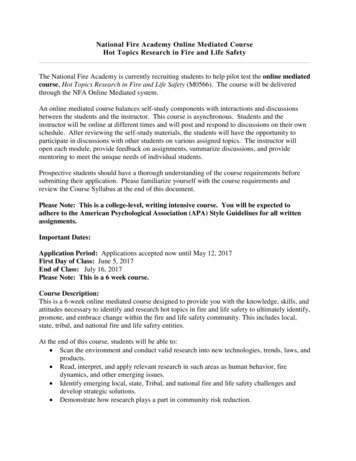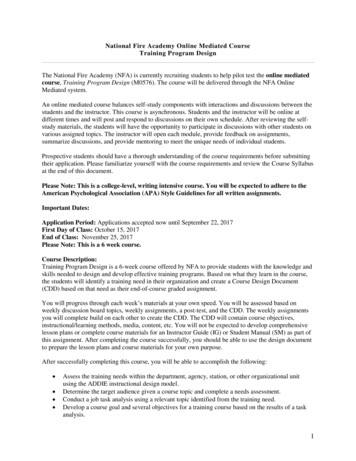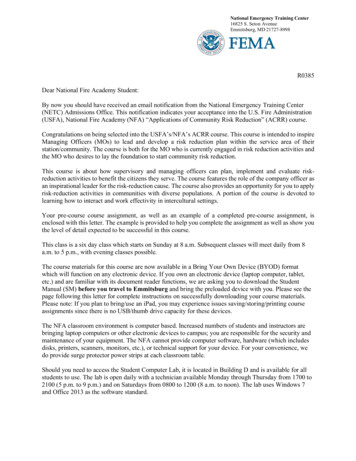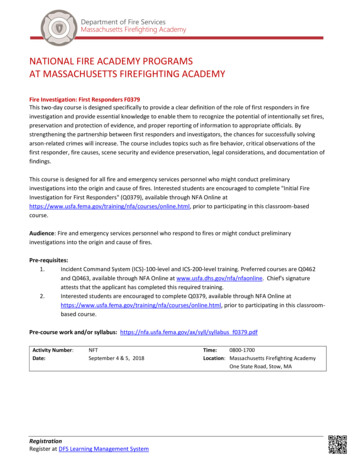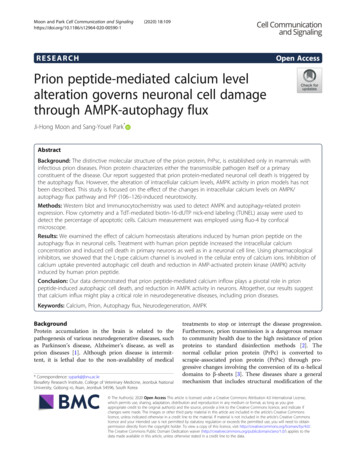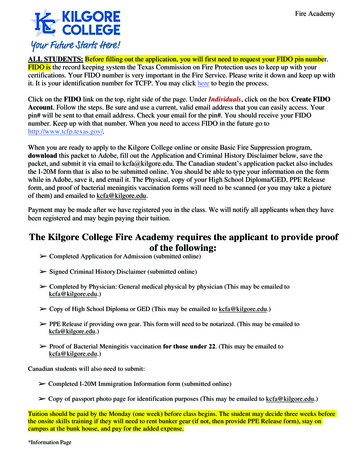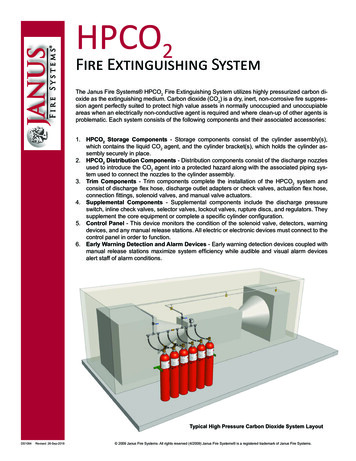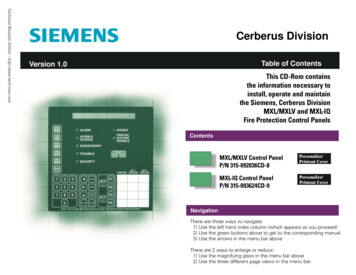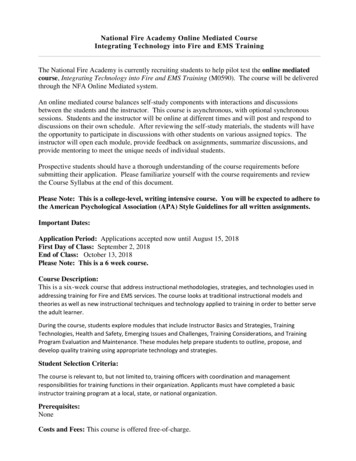
Transcription
National Fire Academy Online Mediated CourseIntegrating Technology into Fire and EMS TrainingThe National Fire Academy is currently recruiting students to help pilot test the online mediatedcourse, Integrating Technology into Fire and EMS Training (M0590). The course will be deliveredthrough the NFA Online Mediated system.An online mediated course balances self-study components with interactions and discussionsbetween the students and the instructor. This course is asynchronous, with optional synchronoussessions. Students and the instructor will be online at different times and will post and respond todiscussions on their own schedule. After reviewing the self-study materials, the students will havethe opportunity to participate in discussions with other students on various assigned topics. Theinstructor will open each module, provide feedback on assignments, summarize discussions, andprovide mentoring to meet the unique needs of individual students.Prospective students should have a thorough understanding of the course requirements beforesubmitting their application. Please familiarize yourself with the course requirements and reviewthe Course Syllabus at the end of this document.Please Note: This is a college-level, writing intensive course. You will be expected to adhere tothe American Psychological Association (APA) Style Guidelines for all written assignments.Important Dates:Application Period: Applications accepted now until August 15, 2018First Day of Class: September 2, 2018End of Class: October 13, 2018Please Note: This is a 6 week course.Course Description:This is a six-week course that address instructional methodologies, strategies, and technologies used inaddressing training for Fire and EMS services. The course looks at traditional instructional models andtheories as well as new instructional techniques and technology applied to training in order to better servethe adult learner.During the course, students explore modules that include Instructor Basics and Strategies, TrainingTechnologies, Health and Safety, Emerging Issues and Challenges, Training Considerations, and TrainingProgram Evaluation and Maintenance. These modules help prepare students to outline, propose, anddevelop quality training using appropriate technology and strategies.Student Selection Criteria:The course is relevant to, but not limited to, training officers with coordination and managementresponsibilities for training functions in their organization. Applicants must have completed a basicinstructor training program at a local, state, or national organization.Prerequisites:NoneCosts and Fees: This course is offered free-of-charge.
How to Apply:Students must complete the General Admission Application ( FEMA Form 119-25-1) available onthe USFA website at: apply.htmlCompleted applications should be submitted by August 15, 2018 to:NETC Admissions Office16825 S. Seton AvenueEmmitsburg, MD 21727Completed applications can also be faxed to the NETC Admissions Office at 301-447-1441.
National Fire AcademyM0590 – Integrating Technology into Fire and EMS TrainingVersion: 1st edition, May 2018Quarter:ACE Credit:IACET Continuing Education Units:Length of Course: Six WeeksPrerequisite: NoneCurriculum: Training Specialist:Instructor:Instructor email/phone:Online Meeting Time:
Table of ContentsM0590 – Integrating Technology into Fire and EMS Training . 3Course Description (Catalog) . 6Student Qualifications . 6Prerequisites . Error! Bookmark not defined.Course Scope (Goal) . 6Course Objectives (Course Learning Outcomes – TLOs) . 6Course Delivery Method . 7Course Schedule. 7Course Resources (Instructional Materials) . 10Grading Methodology (Evaluation Procedures) . 10Discussion Forum Assignments. 10Dropbox Assignments . 11Quiz Assignment . 11Capstone Project Assignment . 11Course Outline . 12Course Overview . 12Welcome and Course Tools . 12Module 0: Pre-Course Work . 13Module 1: Instructor Basics and Strategies . 14Module 2: Training Technologies . 16Module 3: Health and Safety . 18Module 4: Emerging Issues and Challenges . 20Module 5: Training Considerations . 22Module 6: Training Program Evaluation and Maintenance . 25End of Course Evaluation . 27Policies . 27Writing Expectations . 27Citation and Reference Style . 27Late Assignments . 27Netiquette . 28Grading . 28Academic Honesty . 28Grading Rubrics . 29Discussion Forums Grading Rubric . 29Activity 0.1: POI Identification Grading Rubric . 30Activity 1.4: POI Evaluation Grading Rubric. 31Activity 2.2: Web 2.0 Tool Evaluation Grading Rubric . 32
Activity 4.2: Strategies to Address Issues and Challenges . 33Activity 5.4: POI Grading Rubric . 34Activity 6.1: POI Peer Review Grading Rubric. 37Activity 6.2: Final POI Grading Rubric . 38
Course Description (Catalog)M0590 – Integrating Technology into Fire and EMS Training. This is a six-week course that addressinstructional methodologies, strategies, and technologies used in addressing training for Fire and EMSservices. The course looks at traditional instructional models and theories as well as new instructionaltechniques and technology applied to training in order to better serve the adult learner.During the course, students explore modules that include Instructor Basics and Strategies, TrainingTechnologies, Health and Safety, Emerging Issues and Challenges, Training Considerations, and TrainingProgram Evaluation and Maintenance. These modules help prepare students to outline, propose, anddevelop quality training using appropriate technology and strategies.Student QualificationsThe course is relevant to, but not limited to, training officers with coordination and managementresponsibilities for training functions in their organization. Applicants must have completed a basicinstructor training program at a local, state, or national organization.PrerequisitesNoneCourse Scope (Goal)The goal of this course is for students to be able to apply innovative instructional strategies, methodologies,and technologies when proposing and developing training for fire and emergency service issues andchallenges. Throughout the course, students will focus on applying learned material directly to their ownorganizations. The course concludes with a capstone project in which students will develop a POI for a selfselected/instructor approved training concept. After receiving both instructor and peer feedback andmaking appropriate adjustments to the POI, the student will then submit it to their Chief or DesignatedAuthority.Course Objectives (Course Learning Outcomes – TLOs)After successfully completing this course, you should be able to accomplish the following: Review and evaluate instructional theories, concepts, and strategies Assess and apply various training technologies for appropriate applications and needs Identify and determine methods for enhancing Firefighter and EMS health, wellness, and safety Develop training strategies to address emerging issues effecting Fire and Emergency services Apply course concepts to develop a Plan of Instruction Review and provide constructive critique of a peer’s POI, and then defend and justify their own finalPOI
Introduction to Technology in Fire and Emergency Services TrainingCourse Delivery MethodThis distance learning (mediated) course enables you to complete academic work in a flexible manner,completely online. Course materials and access to online discussion forums are made available to you. Youare expected to post your discussion board threads no later than the fourth day of the module time frame(11:59 p.m. EDT/EST) of the assigned activity. The boards will close for responses on sixth day of the moduletime frame (11:59 p.m. EDT/EST).During each of the modules you will also be assigned assignments related to the course content.Assignments should be submitted using the Dropbox feature and are due by the first day of the followingmodule (11:59 p.m. EDT/EST). During the final 2 modules of the course, you are to complete a CapstoneProject in which you propose and submit a POI for an enhanced or new training concept to your Chief orDesignated Authority. This project requires applying the skills and knowledge gained throughout the coursemodules. The Capstone Project must be completed by the Monday (11:59 EDT/EST) following the end of thecourse.Course ScheduleThe course modules are broken down into the following weeks: Week 1 – Modules 0 and 1 Week 2 – Module 2 Week 3 – Module 3 Week 4 – Module 4 Weeks 5/6 – Modules 5 and 6*****NOTE: The Capstone Project requires sign-off by the your Chief or Designated Authority. It isrecommended you schedule accordingly in order to submit the project by its assigned due date.Week/ModulePrecourseActivityAssignments Complete pre-course tasks: Activity 0.1: POIIdentificationo Course Overviewo Welcome and Course Toolso Module 0: Pre-Course Work1 Submit Activity 0.1 by Monday Activity 1.1: InstructionalTheories Knowledge Review Review all Module 1 content Activity 1.2: Fact or Myth? Complete Activity 1.1 quiz by Friday Post initial discussion forum threads by Wednesday7 Activity 1.3: Adult Education
Introduction to Technology in Fire and Emergency Services TrainingWeek/ModuleActivityAssignments Activity 1.4: POI Evaluation(Activities 1.2, 1.3) Respond to at least two other students' postings byFriday (Activities 1.2, 1.3)2 Submit Activities 1.1 and 1.4 by Monday Review all Module 2 content Post initial discussion forum threads by Wednesday(Activities 2.1, 2.3, 2.4) Respond to at least two other students' postings byFriday (Activities 2.1, 2.3, 2.4) Activity 2.1: TechnologyUse Activity 2.2: Web 2.0 ToolEvaluation Activity 2.3: Technologyand InstructionalMethodologies Activity 2.4: SimulationApplication3 Submit Activity 2.2 by Monday Activity 3.1: Near-Miss andFatality Data Review all Module 3 content Post initial discussion forum threads by Wednesday(Activities 3.1, 3.2, 3.3, 3.4) Respond to at least two other students' postings byFriday (Activities 3.1, 3.2, 3.3, 3.4) Activity 3.2: Wearable Devices Activity 3.3: InstructionalMethodologies and Tools toEnhance Health, Wellness,and Safety (ELOs 3.2 and 3.3) Activity 3.4: POI Health,Wellness, and SafetyConsiderations (ELO 3.4)4 Review all Module 4 content Activity 4.1: Local Issues and Post initial discussion forum threads by Wednesday(Activities 4.1, 4.3) Respond to at least two other students' postings byFriday (Activities 4.1, 4.3)Challenges (ELO 4.1) Activity 4.2: Strategies toAddress Issues andChallenges Activity 4.3: Scenario Issuesand Challenges8
Introduction to Technology in Fire and Emergency Services TrainingWeek/ModuleActivity5 and 6 Submit Activity 4.2 by Monday of week 5 Activity 5.1: SWOT Analysis Review all Module 5 content Activity 5.2: Generational Post initial discussion forum threads by Wednesday ofWeek 5 (Activities 5.1, 5.2, 5.3) AssignmentsFactors Activity 5.3: Local Issue POIProposalRespond to at least two other students' postings byFriday (Activities 5.1, 5.2, 5.3) Activity 5.4: POI Submit Activity 5.4 by Sunday of week 6 Activity 6.1: POI Peer Review Submit Activity 6.1 by Wednesday of week 6 Activity 6.2: Final POI Submit Activity 6.2 by Monday following week 69
Introduction to Technology in Fire and Emergency Services TrainingCourse Resources (Instructional Materials) Instructional materials are available online. Pre-course reading: E-Learning Fundaments: A Practical Guide (2015) by Diane Elkins and DesireePinderGrading Methodology (Evaluation Procedures)This section provides instructions on how to initiate and respond to discussions. A “New Thread” isstarted each time you submit an original discussion topic. Generally, the initial post will be 150 to300 words, and the follow-up responses will be 75 to 200 words. Posts and replies should be ofsufficient breadth and depth, providing insight to address the topic. Refer to discussion postassignment grading rubric for specifics.Discussion Forum AssignmentsDiscussion board assignments give you an opportunity to reflect on the course, analyze the aterial,and share opinions with your peers. Responses should follow these guidelines:Demonstrate an analysis of the questions and material while showing an application of your ownthinking on the discussion question. Also, where specified, comment on two other students’ postand any follow- up questions to further demonstrate discussion board question insight, synthesis,analysis, and position or argument. Questions must be answered concisely and accurately.Responding to the main topic: A good title tells something of the nature of your personalresponse. “Response to Discussion 1,” for example, is not a very useful title, particularly ifeveryone in your course uses it. Try to use topic words that will identify your topic: “Response todiscussion about culture change at the company level.”Responding to someone else's response: Make sure that you respond on the document intended so thatyour contribution will line up in the threaded discussion in the right place.Quality discussion responses: Responses such as "I agree," "good question" or "good answer"are not acceptable. Any response that is just an opinion or is unsubstantiated; any response that iscarelessly typed, poorly thought out, grammatically incorrect, or confusing; or any response that isdisrespectful of another student or any other person, etc., is not acceptable. A high-qualityresponse applies a concept from the text or course in a meaningful way or facilitates analysis ofthe course material or topic.Responses should indicate that you have critically thought about the discussion topic anddemonstrate that you can apply and articulate the knowledge you are learning. Your responsesshould be well-organized and grammatically correct. Substantive responses do not simply deliveropinions; they offer justification for those opinions and should cite sources when appropriate.Expected quantity of responses: Full participation in each discussion requires that you not onlyrespond to the initial discussion item but that you return later to read the responses of others andrespond to at least two other people's comments per discussion item unless otherwise noted.Treat it as a conversation.Think about how you would feel if you made an observation in a traditional classroom setting andno one responded.Discussion open and close dates: Be sure to note the start and end dates of the discussions and responsesnoted in the Course Schedule section of this document.Discussion Forum Grading: Discussion board assignments are worth 6 points each and accountfor 55% of the total grade. The discussion forum’s grading rubric can be found in the GradingRubrics section on this document.10
Introduction to Technology in Fire and Emergency Services TrainingDropbox AssignmentsDropbox Assignment Guidelines: These assignments are evaluated on content (demonstratesboth analyzing and application of course material and displays critical thinking) and quality(grammar, syntax, structure). The file name for your assignment paper needs to reflect your nameand the assignment (e.g., John Doe Assignment Name.docx).Dropbox Assignment Grading: Dropbox assignments outside of the Capstone Project activitiesare worth 2-8 points each, and account for 16% of the final grade. These assignments are due onthe first day of (11:59 p.m. EDT/EST) of the next module.Quiz AssignmentThere is one quiz in module 1 worth 5 points and accounts for 3% of the final grade.Capstone Project AssignmentThe Capstone Project activities (5.4, 6.1, 6.2) account for 26% of the final grade. Activity 5.4 is dueSunday of week 6. Activity 6.1 is due Wednesday of week 6, and Activity 6.2 is due the Mondayfollowing course completion. The grading rubric for all assignments can be found the GradingRubrics section of this document.11
Introduction to Technology in Fire and Emergency Services TrainingCourse Ou
The National Fire Academy is currently recruiting students to help pilot test the online mediated course, Integrating Technology into Fire and EMS Training (M0590). The course will be delivered through the NFA Online Mediated system. An online mediated course balance
